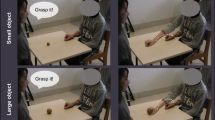Abstract
The maturation of manual dexterity and other sensorimotor functions was assessed with various behavioural tests. In healthy children (age 4–5 years) and in adults, the kinematics of reaching and grasping, a bimanual task and fast repetitive tapping movements were analysed. Furthermore a comprehensive motor function score (MOT), probing agility and balance, was evaluated. In the prehension task, the straightness of the reaching trajectories increased with age. Children opened their grip relatively wider than adults, thus grasping with a higher safety margin. The speed of both tapping and bimanual movements increased with age, and higher scores were reached in the MOT. Although the different behavioural tests sensitively indicated maturational changes, their results were generally not correlated, i.e. the outcome of a particular test could not predict the results of other tasks. Hence there is no simple and uniform relationship between different behavioural data describing maturation of sensorimotor functions.
Similar content being viewed by others
Author information
Authors and Affiliations
Additional information
Received: 20 July 1998 / Accepted: 11 December 1998
Rights and permissions
About this article
Cite this article
Kuhtz-Buschbeck, J., Boczek-Funcke, A., Illert, M. et al. Prehension movements and motor development in children. Exp Brain Res 128, 65–68 (1999). https://doi.org/10.1007/s002210050818
Issue Date:
DOI: https://doi.org/10.1007/s002210050818




